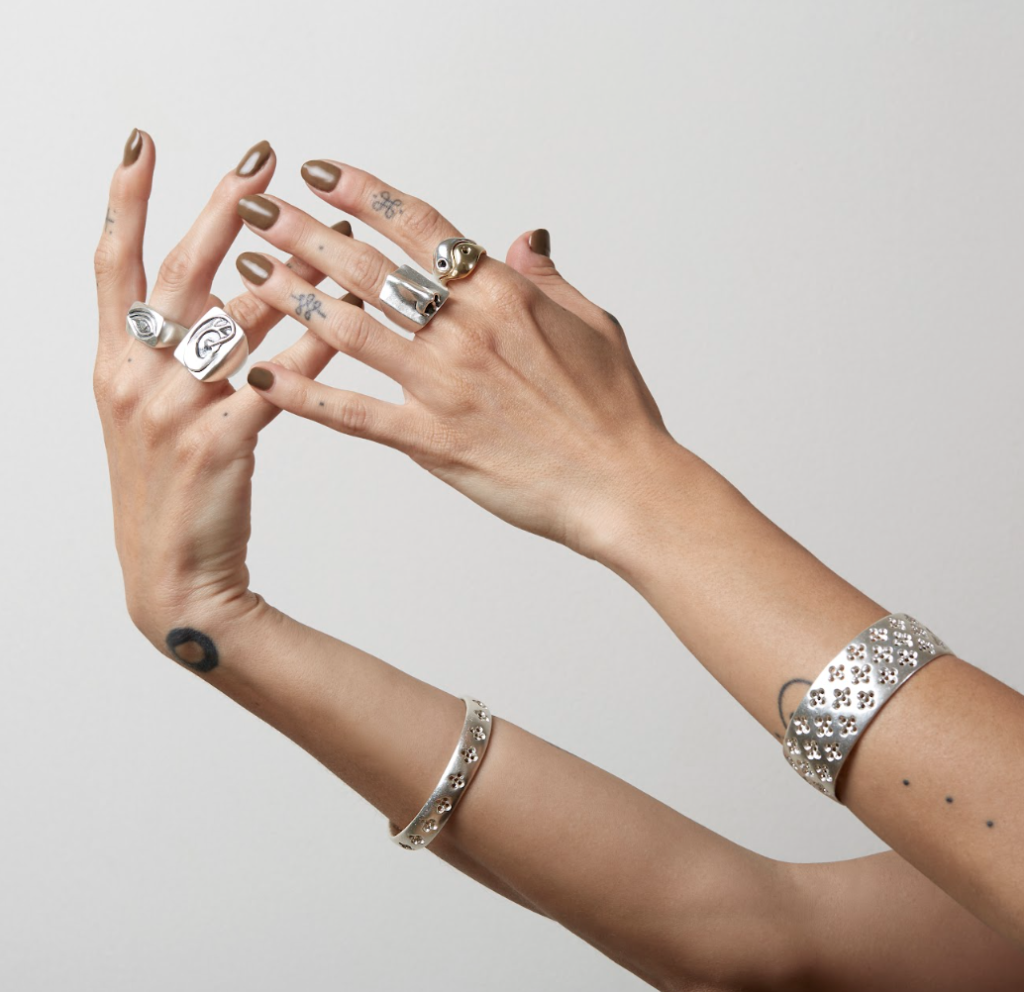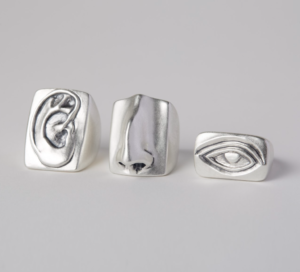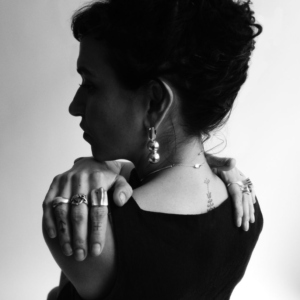Suna Bonometti on creativity, inspiration, and collaborative work
Jewelry design is an old-world artistic expression that has been pursued for centuries. As is with architectural design, you can get as much inspiration from the work created today as you could thousands of years ago. These are two design processes that cultures from around the world have used to express themselves and interpret the world. So it’s not surprising that Italian-American jewelry designer Suna Bonometti gets jewelry design inspiration from the architectural shapes around her and approaches her craft with as much authenticity, originality, and attention to detail as they did in Italy thousands of years back. In a casual talk with DesignSpec co-founder Fiona Sanipelli, a jewelry maker herself, Suna shares the journey of developing her minimal yet sophisticated style, praises the benefits of artistic retreats, and expresses her passion for creating intricate art pieces for interior design.
“I believe that structure and geometry have always been an interest of mine. A lot of inspiration for my work comes from architecture, ancient art, and contemporary art“
Interview
Let’s start with your background. Why did you get into jewelry design and what were the early stages of your education and career?
I started making jewelry or learning to make jewelry when I was a teenager. I took a jewelry-making class in Massachusetts at Snow Farm School of Craft one summer when we came to visit my grandparents because I was living in Italy at the time. And because it was summer, I really wanted to do something, some kind of activity, and so my mom found this school in Massachusetts that was only a drive away from my grandparents’ house. It turned out to be a massive door that opened in my life. I went for two weeks and fell madly in love with this jewelry class. That was basically my first experience, and it was very hands-on. So, as a 14-15-year-old I had already made some jewelry, rings specifically.


I ended up going to that school for the subsequent two years. Later I had to select a major after high school and decided to go to University to study jewelry. I went to London Metropolitan University and did Jewelry, Silversmithing, and Related Arts. That was interesting and very hands-on, it was also focused on design history. London is such a resourceful city for art. It was altogether a very inspiring experience.
So, has it always been jewelry for you?
Well, it’s always been art. I’ve had my hands busy making things since I was a little girl. For example, I made myself a pair of shoes when I was seven or eight because I really wanted high heels. My mom wouldn’t buy them for me, so I made them out of salt dough. It’s a dough that you bake and it hardens. I wore the heels once, then unfortunately they disintegrated. Anyway, I was always working on little sewing projects or doing stuff with my hands like painting and drawing. I went to an art high school. It was always going to be art.
“I’ve always had my hands busy making things since I was a little girl“
When you were in London at school, were you selling pieces that early on or just studying?
I was selling a few pieces, mostly to friends and family. To be completely honest, by the time I finished university, because I went straight out of high school, I was so ready to do something else. So, for two years after graduating, I worked in restaurants and managed a market. That’s how my time was spent. After that, I moved back to Italy and started working for an artist making her sculptures. When I moved to New York a year later, I started working with jewelry again.


What drew you to New York?
I’m half-American and half-Italian, and I grew up in Italy, but I have American citizenship. When I was 25, I came to visit New York and fell madly in love with it. It just felt like such a vibrant, lively place with so many opportunities. I went back to Italy and packed up my stuff, got my cat T-rex, and moved to New York. We lived in Chinatown for the first two months. Then I got lucky. I was looking for the best neighborhood to live in, so I asked a jeweler, Edgar Mosa, that I met at an opening to give me his recommendation. He was living in a loft with a bunch of artists at the time and described it as heaven. Shortly after that conversation, two spots opened in heaven! I immediately went to see it. It was a giant loft with giant rooms, eight people lived there, and each room was an art studio. I think part of the reason I ended up staying in NYC so long is that when I moved to the loft, I was immediately immersed in this artistic environment with a bunch of people who were pursuing their careers in the city just like me. It was helpful to have that kind of community.
For the first five years in New York, I was immersed in this great artistic scene. Then when I moved out of the loft to the studio that I’m in now. There I started frequenting people in the design world. The design world felt more like my place. The artist from the loft gave me a great foundation. Watching these artists pursue their careers by going to openings, networking with people, and making connections. All those things were useful lessons for me.
You mentioned that you feel comfortable in the design world, and your jewelry definitely feels like high design. It’s very architectural and geometric which makes it stand out. How did you come to this specific aesthetic and what were you inspired by?
My work is shifting, and I’m actually trying to go more into organic shapes now. But when I started making work, I was influenced by this one jeweler in Italy. He told me that it’s easier to work with straight lines versus rounder lines. So, for the original collection that I started working on it was about the structure. The bald geometric-shaped image that you see when you look at my first works. In a lot of ways, I liked jewelry to have an interesting engineering aspect to it. Now I think that’s negotiable. Structure and geometry have always been an interest of mine. This is why a lot of inspiration for my work comes from architecture. Recently I have been more moved by ancient folklore art and the natural world.
“I believe that the shapes of the work are vessels for other concepts“


You’ve been involved in a number of artist retreats. Why did you start doing them? Which ended up being the most memorable for you?
They’re kind of like retreats but they’re called residencies. You apply with a proposal and pictures of your work, to demonstrate to the institution that you’re a maker. I feel like I really thrive in them, so I just want to be in residencies all my life. You have access to these incredible state-of-the-art studios, and you’re surrounded by people that you can interact with, collaborate, or learn from. It’s a great opportunity also in the sense that in the majority of the cases, I get access to studios that have the tools that I don’t have.
For instance, I was just at Penland which is this incredible school in North Carolina that runs from spring to fall. In the winter they shut down because it’s cold, but the studios are all still there. So, they open it up to artists for a month, and you can apply to go spend time there making stuff. I got to work a lot on carving wax and casting which is something that I don’t do in my studio here. That was really cool because I had done a little bit of casting before but not a lot. During the retreat, I got to immerse myself in every step of the process.
That does sound really fun. What will a typical day in your own studio look like versus a day at a residency?
Today I am working on some commissions and designs for approval. I’m working with this actor/director/comedian, and I’m making him some stuff for a premiere that’s happening in two weeks. Now it’s all about nailing down the design.
So, he’s leaving the design up to you?
Sort of, that’s the challenging part. There have been many iterations – we’re still figuring it out. It’s been a little hard with this project because I keep proposing things and none of them are just right. I love it more when people trust your style, but this client is very specific. Ideally, I want to have more creative freedom while honoring clients’ needs.


Sure, the work ends up better if both parties are involved in the process. You had a foray for a little while into furniture when you were doing a partnership making a couple of tables. Is that something you think you might pursue again in the future or was this a temporary project?
I would say yes. The utensils I’m making now are my attempt to get back into that world of design but on a smaller scale; a scale I can manage and feel more secure and safe in. With the furniture, I struggled with the size. Not with designing bigger objects, but with moving them, storing them, and managing them. It’s a much bigger investment even in the space needed to run a furniture design studio. I want to work on stuff that I have the tools to work on. I want to make smaller design objects that I can carve or fabricate in the studio and make small batches of.
I know that it can be really hard to make a living as a jewelry designer. What are some of the challenges you’ve been able to overcome in the industry?
I’m not living completely off my own work right now. I still hold a part-time job making pieces for other people. But my business has been expanding and growing more and more every year. I think the biggest challenge I face is juggling all the different aspects of running a small business. So much time is spent on administrative work. Another big challenge has been taking things one step at a time and not getting overwhelmed with all the responsibilities. I have had to remind myself to take baby steps. And sooner or later everything will get accomplished. The bottom line is making sure I am enjoying what I am doing. But then I’ll get reminded by the people who express how happy they are with the jewelry I made for them, and it makes it all worth the hard work.
“Ideally, I want to have more creative freedom while honoring clients’ needs”


Summary:
While Fiona spoke with Suna Bonometti, she felt struck by how similar their creative experience has been and how refreshing it is to partner with clients who celebrate their work and trust the process. Fiona having experience in both jewelry and interior design understood the connection and felt similar about how one could inspire the other. Suna’s experience in making jewelry
translates perfectly into a passion for creating small interior design pieces that can fit in the palm of her hand. And if the client is willing to collaborate and trust her artistic touch, the sky is the limit to what she can do.
At DesignSpec we celebrate artistry like Suna’s and will continue to feature their work. Discover Suna Bonometti’s impressive jewelry collection, and check out her Instagram for artistic inspiration.




